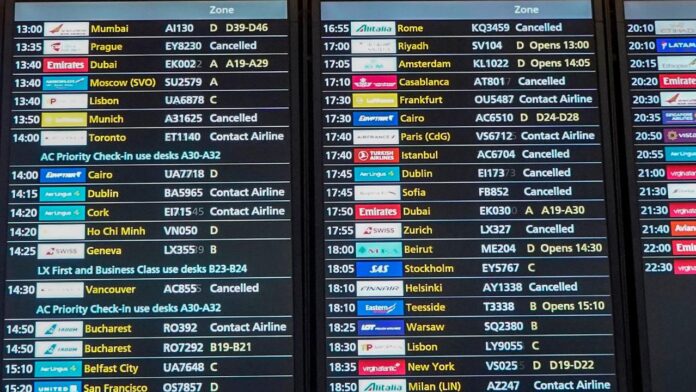[ad_1]
A work from home debacle caused chaos for more than 700,000 air passengers bringing the skies to a standstill, an investigation has found.
It took hours longer than necessary to solve the crisis in Britain’s air traffic control system because a key staff member, who worked at home that day, had to drive 90 minutes into work to attempt to reboot the system manually.
Meanwhile, planes across the world were being grounded with passengers shelling out for alternative transport.
It took six days for some passengers to get on their originally scheduled flights while airlines had to spend millions of dollars on hotels for customers who couldn’t fly.
‘Caused by WFH’
An independent report, commissioned by the UK’s Civil Aviation Authority, found procedures were “wholly inadequate,” at National Air Traffic Services (NATS) which controls aircraft in Britain’s skies and also coordinates the flight path of many planes approaching continental Europe from North America.
“This report is absolutely damning,” an aviation source told the UK’s Times newspaper.
“This was caused by working from home. The engineers responsible for critical national infrastructure were at home.”
The drama unfolded on August 28 last year. A public holiday in the UK, it was one of the busiest travel days of the year with people heading off on summer holidays.
NATS said that a single piece of data in a flight plan for a plane from Paris to Los Angeles, which was overflying the UK, was incorrectly entered into its system.
The data caused both the primary and a backup systems to go into a “failsafe” mode where they were unable to be used.
At the height of the outage, air traffic controllers could only process 60 flights an hour rather than the usual 400.
90 minutes to drive to the office
Hundreds of planes – both in the UK and overseas – were unable to take off while jets in mid flight were diverted to other countries to land.
The engineer who could fix the issue was “on call” at the time and was not on the premises, NATS told the inquiry.
The staff member tried to reboot the system remotely from home but after that didn’t work they had to drive into the NATS main air traffic control centre near Southampton in England’s south.
“Having exhausted remote intervention options, it took 90 minutes for the individual to reach the site in order to perform the necessary full system restart which was not permitted remotely,” the report stated.
It was only three hours after the initial IT glitch that another, more senior, engineer was called in. And it took more than four hours for the software firm involved to be alerted to the problem.
The report said the financial cost to passengers was “very serious,” and the outage caused “serious,” stress and anxiety.
‘Sitting at home’
NATS is owned by a consortium of the UK Government, London’s Heathrow Airport and airlines including British Airways, Virgin Atlantic, easyJet and Lufthansa.
Europe’s largest airline low cost carrier Ryanair, which is not part of NATS, is ropeable about the air traffic control chaos.
“The fact that key NATS engineers were sitting at home during one of the peak travel weekends, combined with findings that NATS has a fundamental lack of pre-planning, documentation, and co-ordination, clearly demands senior management changes,” said Ryanair boss Michael O’Leary who called on NATS CEO Martin Rolfe to resign.
A NATS spokesman said it has co-operated fully with the probe.
“We have not waited for the panel’s report to make improvements for handling future events based on learning from the experience of last year.
“These include a review of our engagement with our airline customers, our wider crisis response and our engineering support processes.”
[ad_2]
Source link


